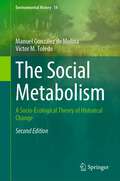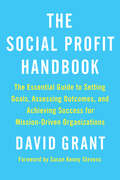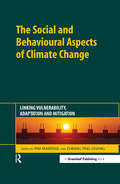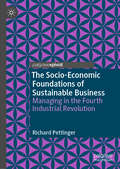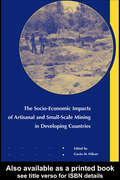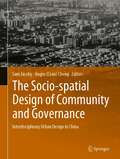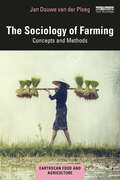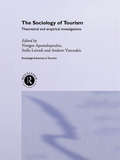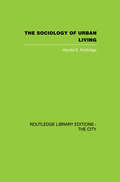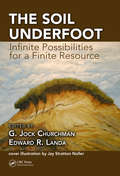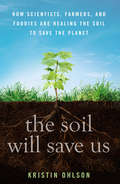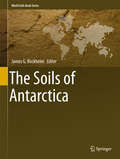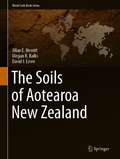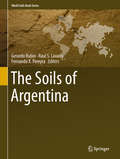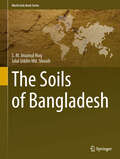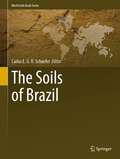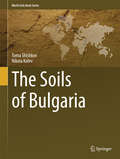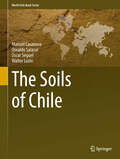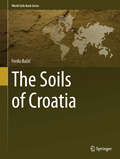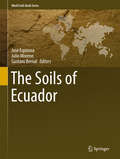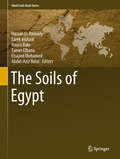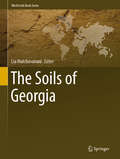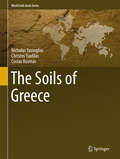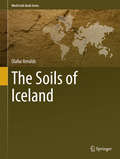- Table View
- List View
The Social Metabolism: A Socio-Ecological Theory of Historical Change (Environmental History #14)
by Víctor M. Toledo Manuel González de MolinaThis book helps readers to understand the fast growing and timely concept of social metabolism. The authors shed a light on the different existing terms and methodologies that have been developed over the years. Through the study of history, readers will get an understanding of the main currents or schools that exist around this concept and their main findings. Also provides examples of how to apply the metabolic approach at different territorial and temporal scales and using different methodological tools. The book presents a novel socio-metabolic theory of historical change, in which biophysical and social variables are combined in an integrated way to understand the dynamics of socio-metabolic transitions.In this second edition, the authors provide valuable updates and new sections to each of the previous chapters. New insights on global phenomena like climate change and the environmental crisis are also considered. As readers will learn, a paradigm shift in almost all areas of research and society will be needed to face the challenges created by the modern industrial society. The authors use a look back in history, to explore the relationship between humans and nature from an evolutionary and thermodynamic perspective. With this approach, readers from history, environmental sciences and social sciences will get valuable insights on possible solutions.
The Social Profit Handbook: The Essential Guide to Setting Goals, Assessing Outcomes, and Achieving Success for Mission-Driven Organizations
by David GrantHow to articulate and assess what success looks likeThe Social Profit Handbook offers those who lead, govern, and support mission-driven organizations and businesses new ways to assess their impact in order to improve future work rather than merely judge past performance.For-profit institutions measure their success primarily by monetary gains. But nonprofit institutions are different; they aim for social profit. How do you measure the success of these social profit institutions, where missions are focused on the well-being of people, place, and planet?Drawing upon decades of leadership in schools and the foundation and nonprofit worlds, author David Grant offers strategies—from creating mission time to planning backwards to constructing qualitative assessment rubrics—that help organizations take assessment back into their own hands, and improve their work as a result. His insights, illustrated by numerous case studies, make this book a unique organizational development tool for a wide range of nonprofit organizations, as well as emerging mission-based social venture businesses, such as low-profit corporations and B Corps.The Social Profit Handbook presentsassessment and evaluation not as ends in themselves but as the path toward achieving what matters most in the social sector. The result: more benefits to society and stronger, more unified, more effective organizations prepared to make the world a better place.
The Social and Behavioural Aspects of Climate Change: Linking Vulnerability, Adaptation and Mitigation
by Pim Martens Chiung Ting ChangOver the past few years, and certainly since the publication of the "Stern Report", there has been increasing recognition that climate change is not only an environmental crisis, but one with important social and economic dimensions. There is now a growing need for multi-disciplinary research and for the science of climate change to be usefully translated for policy-makers.Until very recently, scientific and policy emphasis on climate change has focused almost exclusively on mitigation efforts: mechanisms and regulations to reduce greenhouse gas emissions. The success of such efforts to date is debatable. In fact, the impact of ever more stringent emission control programmes could potentially have enormous social consequences. Little effort has been expended on the exploration of a systematic evaluation of climate stabilization benefits or the costs of adapting to a changed climate, let alone attempting to integrate different approaches. There is an increasing recognition that the key actors in the climate crisis also need to be preparing for change that is unavoidable. This has resulted in a greater consideration of vulnerability and adaptation.The book, based on the research programme "Vulnerability, Adaptation and Mitigation" (VAM) which ran from 2004 to 2010, funded by the Netherlands Organisation for Scientific Research (NWO), presents a cluster of case studies of industries, communities and institutions which each show how vulnerability, adaptation and mitigation analyses can be integrated using social behavioural sciences. Each chapter makes specific recommendations for the studied industry sector, community or institution, analyses the latest research developments of the field and identifies priorities for future research. The book argues that the inherent complexity of climate change will ultimately require a much more integrated response both scientifically – to better understand multiple causes and impacts – as well as at the scientific/policy interface, where new forms of engagement between scientists, policy-makers and wider stakeholder groups can make a valuable contribution to more informed climate policy and practice.The book is particularly timely as the scientific research and policy debate is shifting from one of problem-framing to new agendas that are much more concerned with implementation, the improvement of assessment methodologies from a multi-disciplinary perspective, and the reframing of current scientific understanding towards mitigation, adaptation and vulnerability. A critical element in responding to the climate change challenge will be to ensure the translation of these new scientific insights into innovative policy and practice "on the ground". This book provides some fundamental elements to answer this need.The Social and Behavioural Aspects of Climate Change: Linking Vulnerability, Adaptation and Mitigation will be essential reading for social science researchers and policy managers in the area of climate change, as well as for those who want to know what the social and behavioural sciences can contribute toward coping with climate hazards. NGOs, law firms and businesses in the energy sector or other climate related fields will also find the book of great value.
The Socio-Economic Foundations of Sustainable Business: Managing in the Fourth Industrial Revolution
by Richard PettingerThis book brings together key aspects of contemporary organisations with regard to the socio-economic foundations of sustainable business. We are now in the middle of the Fourth Industrial Revolution; an unprecedented development in technology and society, driven by social, political and economic demands. The Fourth Industrial Revolution is affecting business, but also has social consequences, as can be seen in the present and evolving patterns of economic activity. In turn, these consequences influence and create crucial and central issues regarding value, sustainability, security and assurance – aspects required and demanded by all areas of society.Based on work assessing the US and UK business sectors, including research conducted at the UCL in conjunction with such diverse organisations as the Bank of England, Google, Facebook and the Antwerp Diamond Exchange, this book addresses the key issues and challenges involved in integrating real and virtual environments. In addition, it uses case studies to illustrate the academic theory, blending industry and scholarly literature.Written by an expert in his field, this book delivers a realistic, practical and academically sound foundation for business, management and organisation studies, while also providing an interdisciplinary view on a transforming society, incorporating technology, IT, economics and sociology.
The Socio-Economic Impacts of Artisanal and Small-Scale Mining in Developing Countries
by Gavin M. HilsonThe purpose of this book is to examine both the positive and negative socioeconomic impacts of artisanal and small-scale mining in developing countries. In recent years, a number of governments have attempted to formalize this rudimentary sector of industry, recognizing its socioeconomic importance. However, the industry continues to be plagued by
The Socio-spatial Design of Community and Governance: Interdisciplinary Urban Design in China
by Sam Jacoby Jingru Cyan ChengThis book proposes a new interdisciplinary understanding of urban design in China based on a study of the transformative effects of socio-spatial design and planning on communities and their governance. This is framed by an examination of the social projects, spaces, and realities that have shaped three contexts critical to the understanding of urban design problems in China: the histories of “collective forms” and “collective spaces”, such as that of the urban danwei (work-unit), which inform current community building and planning; socio-spatial changes in urban and rural development; and disparate practices of “spatialised governmentality”. These contexts and an attendant transformation from planning to design and from government to governance, define the current urban design challenges found in the dominant urban xiaoqu (small district) and shequ (community) development model. Examining the histories, transformations, and practices that have shaped socio-spatial epistemologies and experiences in China – including a specific sense of community and place that is rather based on a concrete “collective” than abstract “public” space and underpinned by socialised governance – this book brings together a diverse range of observations, thoughts, analyses, and projects by urban researchers and practitioners. Thereby discussing emerging interdisciplinary urban design practices in China, this book offers a valuable resource for all academics, practitioners, and stakeholders with an interest in socio-spatial design and development.
The Sociology of Energy, Buildings and the Environment: Constructing Knowledge, Designing Practice
by Elizabeth Shove Simon GuyBringing the social sciences to the heart of environmental debate, this book demonstrates the relevance of sociological analysis for environmentally critical issues like energy consumption. Focusing on energy efficiency and the built environment, the authors take a critical look at the production and use of technical knowledge and energy-related expertise. Challenging the conventional assumptions of scientists and energy policy-makers, the book outlines a new role for social research and a new paradigm for environmental policy.
The Sociology of Farming: Concepts and Methods (Earthscan Food and Agriculture)
by Jan Douwe van der PloegThis book provides a detailed and comprehensive introduction to the concepts and methods of the sociology of farming. The sociology of farming focuses on co-production: the ongoing interaction and mutual transformation of the natural and the social (of ‘human and living nature’) which requires putting the farm labour process centre stage. While there are many books which discuss food and agriculture, this book is different: it delves into the methods and concepts used and presents a comprehensive conceptual framework and the associated methods for research to give students and researchers of agriculture and rural studies a solid set of tools for unravelling the complexities of farming and rural life. Importantly, these tools also empower us to design new ways forward. A wide array of case studies, as wide-ranging as Brazil, Peru, China, the Netherlands, Italy and Guinea Bissau, help readers to grasp the commonalities that underlie strongly diversified and divided rural worlds. The book lists over two hundred basic concepts and includes boxes that discuss the main methods of the sociology of farming. This textbook is essential reading for students and scholars of food and agriculture, agrarian studies, rural development, food and farming systems, peasant studies and environmental sociology.
The Sociology of Tourism: Theoretical and Empirical Investigations (Routledge Advances in Tourism #Vol. 1)
by Yiorgos Apostolopoulos Stella Leivadi Andrew YiannakisThe rapid expansion of the tourism industry has provided many economic benefits and affected every facet of contemporary societies including employment, government revenue and cultural manifestations. However, tourism can also be considered a problematic phenomenon, promoting dependency, underdevelopment and adverse sociocultural effects, especially for developing countries. This pioneering work provides a comprehensive review of these complex tourism issues from a sociological perspective. Various theoretical and empirical approaches are introduced and the following issues are discussed: * identifiable and stable forms of touristic behaviour and roles* social divisions within tourism* the interdependence of tourism and social institutions* the effects of transnational tourism and commodification on the ecosystem.Featuring international contributions from nine different countries, this book brings together the most noted theoretical and empirical studies and enriches them with diverse experiences and perspectives.
The Sociology of Urban Living
by Harold E. NottridgeThe urban setting in which people live has an important influence upon the organization and planning of their social lives. H. E. Nottridge here presents a valuable introduction to the field of urban sociology, showing that it is a theoretical discipline which is worthy of consideration in its own right. Throughout his account Mr Nottridge places strong emphasis on the need for comparative perspectives. He uses a wide range of source material from urban environments as far apart as shanty towns in developing countries and the great metropolitan complexity of London. He covers such topics as scope and methods in urban sociology, social differences in towns and , in the context of urban social structure, the family and network theories. He also analyses the work of the Chicago School of Weber, Tonnies, Park, Redfield and Wirth, assessing their value for mdoern urban sociology. The author concludes with an examination of housing, migration and urban poverty. This book was first published in 1972.
The Soil Underfoot: Infinite Possibilities for a Finite Resource
by Edward R. Landa G. Jock ChurchmanThe largest part of the world's food comes from its soils, either directly from plants, or via animals fed on pastures and crops. Thus, it is necessary to maintain, and if possible, improve the quality-and hence good health-of soils, while enabling them to support the growing world population. The Soil Underfoot: Infinite Possibilities for a Finite
The Soil Will Save Us: How Scientists, Farmers, and Foodies Are Healing the Soil to Save the Planet
by Kristin OhlsonThousands of years of poor farming and ranching practices—and, especially, modern industrial agriculture—have led to the loss of up to 80 percent of carbon from the world's soils. That carbon is now floating in the atmosphere, and even if we stopped using fossil fuels today, it would continue warming the planet. In The Soil Will Save Us, journalist and bestselling author Kristin Ohlson makes an elegantly argued, passionate case for "our great green hope"—a way in which we can not only heal the land but also turn atmospheric carbon into beneficial soil carbon—and potentially reverse global warming.As the granddaughter of farmers and the daughter of avid gardeners, Ohlson has long had an appreciation for the soil. A chance conversation with a local chef led her to the crossroads of science, farming, food, and environmentalism and the discovery of the only significant way to remove carbon dioxide from the air—an ecological approach that tends not only to plants and animals but also to the vast population of underground microorganisms that fix carbon in the soil. Ohlson introduces the visionaries—scientists, farmers, ranchers, and landscapers—who are figuring out in the lab and on the ground how to build healthy soil, which solves myriad problems: drought, erosion, air and water pollution, and food quality, as well as climate change. Her discoveries and vivid storytelling will revolutionize the way we think about our food, our landscapes, our plants, and our relationship to Earth.
The Soils of Antarctica
by James G. BockheimThis book divides Antarctica into eight ice-free regions and provides information on the soils of each region. Soils have been studied in Antarctica for nearly 100 years. Although only 0. 35% (45,000 km2) of Antarctica is ice-free, its weathered, unconsolidated material qualify as "soils" Soils of Antarctica is richly illustrated with nearly 150 images and provisional maps are provided for several key ice-free areas.
The Soils of Aotearoa New Zealand (World Soils Book Series)
by Allan E. Hewitt Megan R. Balks David J. LoweThis book offers an introduction to the soils of Aotearoa New Zealand, structured according to the New Zealand soil classification system. Starting with an overview of the importance and distribution of New Zealand soils, it subsequently provides essential information on each of the 15 New Zealand soil orders in separate chapters. Each chapter, illustrated with diagrams and photographs in colour, includes a summary of the main features of the soils in the order, their genesis and relationships with landscapes, their key properties including examples of physical and chemical characteristics, and their classification, use, and management. The book then features a chapter on soils in the Ross Sea region of Antarctica and concludes by considering New Zealand soils in a global context, soil-formation pathways, and methods used in New Zealand to evaluate soils and assist in land-management decisions. Information about how to access detailed information via links to the Manaaki Whenua Landcare Research website is also included.
The Soils of Argentina (World Soils Book Ser.)
by Gerardo Rubio Raul S. Lavado Fernando X. PereyraThis is the first comprehensive book on Argentinian pedology. It discusses the main soil types of Argentina, their geographical distribution, classification, functions, agricultural use, ecological aspects, and the threats to which they have been subjected during centuries of intensive and extensive management. The description of the soils is accompanied by a complete set of data, pictures and maps, including benchmark profiles and an overview of the country's agricultural production. It also deals with future scenarios of the relationships between soil science and other disciplines and the main challenges that soil science will face in the future. Further, the book explores aspects of the main soil forming factors, such as climate, vegetation, geology and geomorphology, making use of new, unpublished data and elaborations, and presents a history of pedological research in Argentina.
The Soils of Bangladesh
by Jalal Uddin Shoaib S.M. Imamul HuqThis book presents a comprehensive overview of the soils of Bangladesh. It is compiled by authors with vast experience in soil related problems and potential mitigation approaches. It discusses the development of Soil Science as an individual discipline in a country with limited resources and where soil plays a pivotal role for the economy; the formation of different agro-climatic regions; and the effects of human-induced soil degradation and climatic change on its soils, geology and geomorphology and major soil types. It examines 'problem soils' and how they are managed, the scenario of soil fertility status, and land and crop management, as well as focusing on the future soils. Topics covered include: the history of soil research in Bangladesh; agro-climatic regions of Bangladesh; soil and climatic change, major soil types; soil maps; soil properties; soil classification; soil fertility; land use and vegetation; land use changes; human-induced soil degradation; soil contaminants; and future soil issues. This book will be a valuable resource for researchers and soil science professionals.
The Soils of Brazil (World Soils Book Series)
by Carlos E. G. R. SchaeferThis book represents the first comprehensive edition, in English, on the soils of Brazil, in the challenge of illustrating all the biomes of a country of truly continental dimension. In addition to presenting the first geosystemic view of Brazilian soils, in all geological, geomorphological and environmental aspects, the book also makes a key contribution to the discussion of current topics in Pedology, such as Anthrosols, Technosols, Soil Management trends and sustainability, Pedometrics and advanced techniques of digital soil mapping. The soils of Brazil were conveniently stratified into sectors and treated within the different biomes, without neglecting any area of the Brazilian territory. Considering the aspects of the landscape of occurrence, climates, geomorphology and geology, each pedological region was abundantly documented with soil profile data and many fine original, three-dimensional illustrations and diagrams, made with care by the authors. Among the regions, the most important are the forested Amazon, the Central Plateau with Cerrados, the Caatingas of the northeastern semi-arid region, the Atlantic Forest in all known variants; in addition, the Restingas, Mangroves, Oceanic Islands, Wetlands of the Pantanal and the subtropical regions of the Pampa and Matas de Araucaria. The book is of great importance as the first published work on Brazilian soils, but it is of great interest to geologists and geomorphologists who study the tropics and subtropics, due to the novelty and scope of the work.
The Soils of Bulgaria
by Toma Shishkov Nikola KolevThe Soils of Bulgaria offers a comprehensive analysis of the characteristics of soils and concepts on their magnitude. The purpose of the book is to introduce readers to the soil problematic and ecology in Bulgaria. The volume is divided into 3 parts. The first includes historical facts on soil research in Bulgaria, as well as general conditions and factors of soil formation, while the second applies an original pedological approach. The book's third part focuses on essential information concerning land use/cover in Bulgaria. Each of the 13 chapters deals more specifically with fundamental chemical and physical soil properties, concepts of soil evolution, old and modern processes, geographic distribution, climatic conditions, topography, parent materials, plant associations, morphology and the relationship with different classification systems. The interactions between soil status and management are also highlighted. The use of the latest, statistically significant data ensures precise conclusions. The book also includes a large number of charts and new illustrations. The Soils of Bulgaria is crucial reading material for anyone interested in soil management and agriculture in Easter Europe, from students to policy makers and is also of particular interest for researchers in the field.
The Soils of Chile
by Manuel Casanova Oscar Seguel Osvaldo Salazar Walter LuzioThis book is intended for students and soil scientists who want to know about the state of the art in soil sciences in Chile. The book merges a comprehensive bibliographical review of the soil surveys carried out throughout the length and breadth of Chilean territory during the past 40 years and more recent information obtained by the authors in a number of field studies. As its starting point the book presents a general overview of important features related to Chilean soils, such as geology and geomorphology, climate, land use and vegetation. In this long and narrow country different soil formation factors and processes have resulted in a broad variety of soil bodies, from the extremely arid Atacama desert to the Patagonian and Antarctic zones. This book provides a description and classification (mainly Soil Taxonomy) of the most important soil types. Particularly important are soils derived from volcanic materials, which cover extensive areas of Chile. The book also deals with soil management topics in relation to the chemical, physical and biological properties of Chilean soils and it includes a number of examples from throughout the country. Finally, the book shows how man has induced severe soil degradation problems in Chile, such as erosive soil degradation, non-erosive soil degradation and land desertification.
The Soils of Croatia
by Ferdo BašićThe Soils of Croatia is a six-chapter book detailing all aspects of Croatian soils. The book presents, in a reader friendly way, the lively history of pedology in Croatia. It explains soils as natural resources for this country and offers a detailed view on the different agricultural regions referenced in Croatia. The Soils of Croatia also contains useful information regarding the different factors of soil genesis in the different regions as well as on soil taxonomy and it gives a very detailed classification of different Croatian Soils. Overall, this book contains everything that pedologists, students and anyone else interested in Croatian soils should know about.
The Soils of Ecuador
by Julio Moreno José Espinosa Gustavo BernalThis is the first book to comprehensively discuss Ecuadorian soils. Richly illustrated, it provides information on the unique characteristics and distribution of these soils. Due to the influence of the Andes, which vastly modified the climate and parental materials, a relative small country like Ecuador has a wide variety of soil orders, rarely found in other countries. The country is divided into three distinctive regions by the Andes: The Coastal Plain, the Andean Highlands, and the Amazonia Region each with different soil development, influenced by the varying conditions in that region. It is also necessary to consider the Galapagos Islands as a separate region with a particular climate and parental material.
The Soils of Egypt (World Soils Book Series)
by Hassan El-Ramady Tarek Alshaal Noura Bakr Tamer Elbana Elsayed Mohamed Abdel-Aziz BelalThis book reviews the distribution of soils across Egypt, their history, genesis, pollution and management. The conservation of Egyptian soils, soils and their connections to human activities, as well as some future soil issues are also highlighted. It is well known that soil is the main source for food, feed, fuel and fiber production. Accordingly, the study of soils is not only a crucial issue but also an urgent task for all nations worldwide. Due to their important roles in agroecosystems as well as many aspects of our lives, soils have direct and indirect functions in the agricultural, industrial and medicinal sectors. Therefore, understanding the physical, chemical and biological properties of soils, as well as soil security, have now become emerging issues. Climate change has a very dangerous dimension in Egypt concerning the rising sea level. Many coastal zones are already threatened by this sea level rise, and may ultimately disappear. At the same time, water shortages and soil pollution represent the main challenges for the Egyptian nation. Generally speaking, the environmental challenges that Egypt now faces include improving and sustaining soil health, soil carbon sequestration, wastewater treatment, and avoiding the overuse of fertilizers and pesticides. Therefore, this book examines in detail the soils of Egypt from various perspectives including their genesis, history, classification, pollution and degradation, soil security, soil fertility and land uses.
The Soils of Georgia (World Soils Book Series)
by Lia MatchavarianiThis book provides an extensive overview of the diversity of soils in Georgia. It highlights the soil-forming environment (climate, geology, geomorphology), the characterization of the physical, chemical and morphological (macro-, micro-) properties of soils, the history of soil research in Georgia, and the geographic distribution of different soil types. In addition to describing the soil cover, the book also zones and classifies the soils. Past and current land use issues, ecological properties and implications of soils, and many other aspects are elaborated on; special attention is paid to anthropogenic soil degradation due to the contamination and erosion of soils in Georgia. This comprehensive and richly illustrated book, which includes a wealth of pictures and soil maps, offers an essential field guide for soil scientists, geographers and researchers in related areas.
The Soils of Greece
by Nicholas Yassoglou Christos Tsadilas Costas KosmasThis book presents a comprehensive and up-to-date overview on soils of Greece. It includes sections on soil research history, climate, geology, geomorphology, major soil types, soil maps, soil properties, soil classification, soil fertility, land use and vegetation, soil management, soils and humans, soils and industry, future soil issues. The book summarizes what is known about the soils in Greece in a concise and highly reader-friendly way.
The Soils of Iceland
by Olafur ArnaldsIn this new volume in the World Soil series, the various types of Icelandic soils, their different characteristics, their formation, degradation and erosion are reviewed. At the same time, the book also deals with the agriculture and land use in general to give a complete view of Icelandic soils. The first part details the natural parameters such as the climate and the geography of Iceland. It also explains Icelandic geology, which is the major parameter controlling the soil formation in this country. The author describes the formation of Iceland, the main volcanic systems, central volcanoes, tephra production and its influence on the soils. Explanations on rocks, glaciers, rivers and other main geologic features are also given. The book continues with a description of the Icelandic geomorphology, giving insights on the main surface types, frost, cryoturbation and other cryogenic features. Then it details the different types of soils, their formation and main features, comparing the Icelandic soils to other soils elsewhere in the world. Erosion and land degradation are then reviewed, including the exceptionally active wind erosion and dust production. Finally, it gives an insight on land use, agriculture and vegetation types. All this accompanied by the most amazing photos to illustrate the great diversity of Icelandic Soil.
